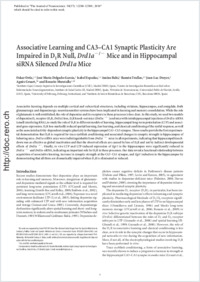Associative learning and CA3–CA1 synaptic plasticity are impaired in D1r Null, Drd1a–/– mice and in hippocampal siRNA silenced Drd1a mice
- Ortiz, Oskar Instituto Cajal, Consejo Superior de Investigaciones Científicas (CSIC), Madrid, Spain - Centro de Investigación Biomédica en Red sobre Enfermedades Neurodegenerativas, Instituto de Salud Carlos III, Madrid, Spain
- Delgado-García, José María División de Neurociencias, Universidad Pablo de Olavide, Sevilla, Spain
- Espadas, Isabel Instituto Cajal, Consejo Superior de Investigaciones Científicas (CSIC), Madrid, Spain - Centro de Investigación Biomédica en Red sobre Enfermedades Neurodegenerativas, Instituto de Salud Carlos III, Madrid, Spain
- Bahi, Amine Department of medicine, University of Fribourg, Switzerland
- Trullas, Ramón Centro de Investigación Biomédica en Red sobre Enfermedades Neurodegenerativas, Instituto de Salud Carlos III, Madrid, Spain - Instituto de Invest Biomédicas de Barcelona, CSIC, Barcelona, Spain
- Dreyer, Jean-Luc Department of medicine, University of Fribourg, Switzerland
- Gruart, Agnès División de Neurociencias, Universidad Pablo de Olavide, Sevilla, Spain
- Moratalla, Rosario Instituto Cajal, Consejo Superior de Investigaciones Científicas (CSIC), Madrid, Spain - Centro de Investigación Biomédica en Red sobre Enfermedades Neurodegenerativas, Instituto de Salud Carlos III, Madrid, Spain
-
2010
Published in:
- The Journal of Neuroscience. - 2010, vol. 30, no. 37, p. 12288-12300
English
Associative learning depends on multiple cortical and subcortical structures, including striatum, hippocampus, and amygdala. Both glutamatergic and dopaminergic neurotransmitter systems have been implicated in learning and memory consolidation. While the role of glutamate is well established, the role of dopamine and its receptors in these processes is less clear. In this study, we used two models of dopamine D₁ receptor (D₁R, Drd1a) loss, D₁R knock-out mice (Drd1a–/–) and mice with intrahippocampal injections of Drd1a-siRNA (small interfering RNA), to study the role of D₁R in different models of learning, hippocampal long-term potentiation (LTP) and associated gene expression. D₁R loss markedly reduced spatial learning, fear learning, and classical conditioning of the eyelid response, as well as the associated activity-dependent synaptic plasticity in the hippocampal CA1–CA3 synapse. These results provide the first experimental demonstration that D₁R is required for trace eyeblink conditioning and associated changes in synaptic strength in hippocampus of behaving mice. Drd1a-siRNA mice were indistinguishable from Drd1a–/– mice in all experiments, indicating that hippocampal knockdown was as effective as global inactivation and that the observed effects are caused by loss of D₁R and not by indirect developmental effects of Drd1a–/–. Finally, in vivo LTP and LTP-induced expression of Egr1 in the hippocampus were significantly reduced in Drd1a–/– and Drd1a-siRNA, indicating an important role for D₁R in these processes. Our data reveal a functional relationship between acquisition of associative learning, increase in synaptic strength at the CA3–CA1 synapse, and Egr1 induction in the hippocampus by demonstrating that all three are dramatically impaired when D₁R is eliminated or reduced.
- Faculty
- Faculté des sciences et de médecine
- Department
- Département de Médecine
- Language
-
- English
- Classification
- Biological sciences
- License
-
License undefined
- Identifiers
-
- RERO DOC 20816
- DOI 10.1523/JNEUROSCI.2655-10.2010
- Persistent URL
- https://folia.unifr.ch/unifr/documents/301576
Statistics
Document views: 94
File downloads:
- pdf: 208
